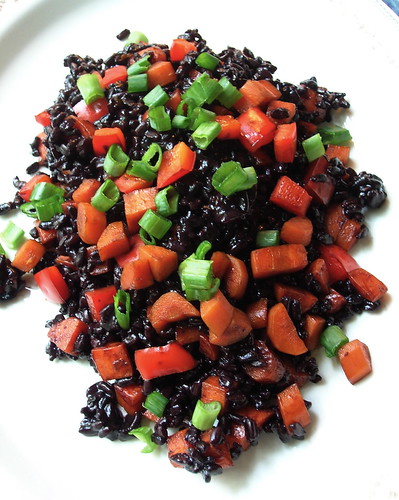

Every time I walk into New York's Kalustyan's, an international grocery, I'm always entranced by the array of rice displayed along the right side wall. A veritable rainbow of Bhutanese red rice, green Bamboo rice, black japonica, Camargue red, purple jasmine, brown rice, wild rice, basmati, sticky rice, sushi rice, short grain, long grain, oh the possibilities! Of course, I'm always attracted to buy some, but the problem is we aren't really rice eaters. Sure, I stir up a risotto now and again and I'm the first to jump at an invitation for my friend's special Iranian pilaf, but overall we aren't big on the rice front. When my Chinese friend describes the number of rice cookers she has to put into use when her family visits I practically blanch in horror. And yet, everytime I walk into Kalustyan's I'm tempted, which is why I've got four unopened bags of rice in my cabinet.


I decided to put some of that rice to good use, "look, this one's called forbidden rice, it says it was prized by Chinese emperors," I said as I pulled it from the cabinet. P. who lived in Hong Kong, just laughs at me, "they call everything in China 'forbidden,' '' he says. Yes, it's probably a marketing ploy, but the fact is this Chinese rice has a lot of other things going for it. The rice is an heirloom Chinese variety whose black color comes from its whole bran exterior. This means it is high in fiber and the deep purple hue it emits hints at a wealth of phytonutrients and iron, another reason you can find it at many health food stores. But most importantly, the rice is delicious, with a deep nutty taste and aroma. I combined it with soy-glazed carrots and red pepper and scallions, not a traditional recipe, but certainly a delicious one. It's one of those dishes that you find yourself shoveling one forkful after another, scooping up soft little grains and salt-edged vegetables in every delectable bite. At dinner there were no jokes about forbidden emperors, only a nice story about traveling in China, told between approving gusty bites. Which was a good beginning, because we still have three and a half bags to go.
With October 31 around the corner, I can't help but think this orange-and-black dish is perfect for the holiday. Happy Halloween!

Forbidden Rice Pilaf
An heirloom variety of Chinese black rice sometimes called forbidden rice, it is available at many health food stores and gourmet markets (do not confuse it with Thai purple sticky rice, which must be handled differently). Serves 4.
1 1/2 cups Chinese black rice
3 cups water
olive oil, salt
1 red bell pepper, diced
2 large carrots, peeled and cut into small dice
3 tbl soy sauce
1/2 cup chopped green onions (scallions)
1. Rinse the rice in three changes of water, until the water begins to run clear (the water will still be a little purple, but should not be cloudy). Bring the three cups of water to a boil with a pinch of salt. Add the rice to the boiling water, cover the pot and simmer over low heat for 35 minutes, until rice is tender and water absorbed.
2. Meanwhile, choose a pan with a tight-fitting lid and heat some olive oil in it. Saute the bell pepper until softened and darkened in a a few spots. Set the pepper aside. Wipe out the pan and heat some more olive oil in it. Add the carrots, stirring to coat them in the oil, then cover the pan with the lid and turn the heat to very low. Sweat the carrots until softened, about 15-20 minutes (you should not need to add any liquid to the pan, but if it looks dry you can add a bit of water). Uncover the pan, raise the heat to medium, add the soy sauce and swirl around so that the sauce reduces a bit and coats the carrots. Remove the pan from the heat and stir in the reserved bell pepper.
3. When the rice is done, combine it with the carrots and pepper and taste for seasoning. You may want to add a bit of red pepper, or a few more drops of soy sauce. Turn rice out onto a platter. Top with the scallions. Serve immediately.

this is one my favorite rice varieties to make desserts with! the color, the deep flavor, its inherent sweetness. It works especially well with Pandan leaves too.
ReplyDelete(PS. thank you for visiting eggbeater on the subject of Mastic. It was an honor to have you in the discussion.)
oooh that looks gorgeous! i love this rice! its used to make a dessert in southeast asia called bubur hitam (black porridge). with coconut cream, pandan leaves and palm sugar. mmm.
ReplyDeleteShuna- what a great idea, I bet the nuttiness works really well in sweet applications.
ReplyDeleteI'm honored to have you comment here, I've been following your new restaurant project avidly, though I haven't commented before. I'm happy to share whatever meager knowledge I've amassed in my times in the Middle East, and look forward to reading more about your projects.
Colored Light- I thought that pudding was made with Thai sticky purple rice, not this Chinese rice?? I ask because I actually have purple sticky rice in my cabinet (one of the unopened bags!) and I know sticky rice behaves very differently from other rice. Either way, the dish you describe sounds delicious!
oh! hmm. yes that does sound reasonable! since the rice i am thinking about is fairly glutinous. oh dear it just boggles my mind that there's more than 1 kind of purple rice! however, if it is nutty and sweet, i'm sure it would be nice as a desert as well. and coconut cream with rice is just a perfect combination. even normal basmati rice cooked with a bit of coconut cream and pandan leaves turns into a real treat to go with curry!
ReplyDeleteThe color is lovely! Being an Asian myself, I am used to rice cooker for so many years... Cooking over a stove top will be hard for me I must confess!
ReplyDeleteI've never worked with this type of black rice before---sounds great--wonderful recipe.
ReplyDeleteThe color is so saturated - just stunning. I'll have to check out that shop!
ReplyDeleteAnh- I'm sure you could do this rice in a rice cooker, no worries.
ReplyDeletechef jp- you should definitely keep your eye out for forbidden rice, it's really fabulous in all sorts of applications.
Amanda- You haven't been to Kaulstyan's?!! Oh, you must go, even though it's billed as Middle Eastern and Indian imports, it's really international, and has lots of Mediterranean-oriented stuff.